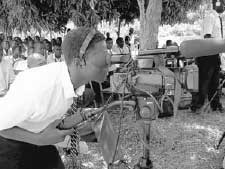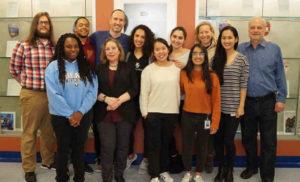
The students walk up the stage, wearing masks. One-by-one they tell their heart-rending tales on Aids.
The colorful masks veil their faces and give them the courage to speak up about the epidemic and its devastating effects on their communities. The masks also seem to give their presentations the punch, resulting in a powerful collective picture, one of the people who have seen the worst of the epidemic – and their resolve to roll it back.
From behind their veils, the students narrate painful experiences with a disease: How it has forced them to face harsh realities at tender ages and left some of them destitute by taking away parents after depleting their resources.
But in their sad stories lies hope, thanks to a partnership between Okok Secondary School in Kisumu District of Nyanza Province and Kiboko Projects, an American non-governmental organization working with children from diverse cultures in campaigning against the disease worldwide.
The project is using schools to reach out to the wider community with messages on HIV and Aids, providing an avenue for students and other residents to express themselves and relate their experiences as one way of coming to terms and coping with the epidemic.
Students address HIV/Aids issues through mask-making, storytelling, photo diaries, painting, theatre, and video interviews. Through the various media, they capture the challenges of families ravaged by the epidemic and the tribulations children face after the death of their parents and relatives.
Correct misperception
One aim of the project is to spread the message far and wide. That is why Okok has been linked to Eleanor Roosevelt High School in New York City in an exchange program that encourages sharing of experiences. It is hoped the exchanges will correct misperceptions by students from both countries and create a common understanding of how to fight the epidemic.
For Jenipher Anyango, a 14-year-old Form One student, the project has opened her eyes and strengthened her resolve to do something to contain the spread of HIV, the virus that causes Aids.
Anyango, who is among the girls involved in making masks and recording video interviews, says working with these media has given her the courage to speak openly about HIV and Aids, which she could not do in the past due to the stigma attached to the disease.
“This way of communicating gives you the courage to speak. With a mask covering your face, you get to speak openly and the veil of fear is also lifted,” she says.
Anyango says she can now face the world and her peers to talk openly about the epidemic.
“I didn’t know the youth have a role to play in society by speaking openly and boldly on issues that affect not only us but also our elders. Through the exposure we have to work with students in other parts of the world through this project, a sense of duty has been instilled in us and we are prepared for the challenges.”
Anyango says young people should be helped to take up their roles in society by being exposed to activities that prepare them for such roles. Says the teenager: “It is our duty as much as it is for the older people to address issues related to Aids as they equally affect and infect us, but without such exposure, which builds self-confidence in us, we cannot effectively play our part.”
Paul Bugi, 17, agrees. The Form Three student says his personal experience with the artistic projects, especially mask-making, has given him a better view of how to deal with issues related to the epidemic.
“It was not easy before, but my experience with the masks and paintings has invigorated and encouraged me to address these issues,” he says.
The school’s principal, Mr. Kariako Malachi, says the Kiboko activities have not only instilled confidence in his students but have also unlocked their potential.
“Through the projects, we have seen potential journalists conducting interviews and also artists in the making communicate through powerful paintings and drawings,” he said.
Kiboko Projects was started seven years ago by New York artists Mark Scheflen and Jill Raufman. It has since grown into a flourishing cultural organization that has organized workshops, exhibitions, and cultural exchange programs on three continents.
Neglected children
It aims to provide “opportunities for artistic and creative expression to individuals, some of whom have had limited access to this experience”.
The organization reaches out to communities through art and education, encouraging people of all ages and diverse backgrounds to tell their “unfiltered” stories to the world. For instance, in Kiboko Projects you will find people ranging from those living with HIV/Aids, the physically and mentally handicapped, children from neglectful families, immigrants, and ex-convicts, to students and professional artists.
Exhibitions are an important vehicle for linking people from various communities to taking part in the project. Last year, works by Kenyan communities were featured in one such show in St Petersburg, bringing the reality of Aids in Africa to the people of the second-largest city in Russia, where Aids is becoming a matter of concern.
The show, hosted by the Artists Union of Russia, featured five diverse projects created through workshops with artists, students, and families in Kenya, America, and St Petersburg itself. On display were hand-painted masks and insightful photo diaries.
Also on show were videos telling compelling stories: A family of children aged 13-18 years orphaned by Aids; a young woman who turned to prostitution to pay her school fees; a 29-yearold father of four struggling to make sure his children are cared for after he dies of Aids-related illnesses.
Ms. Raufman, Kiboko Projects executive director, says she has learnt to appreciate the power of arts. “The young and old have been able to pass information through arts, helping not only in the war against Aids but also overcoming other challenges.”
Ms. Raufman believes fighting stigma is an important strategy in the war on Aids: “People need to know about it, that’s when the stigma starts to fall off.”
Mr. Scheflen, a photographer/teacher and former construction worker, is not new to Kenya. He first visited the country in 1985 and was moved by the people’s warmth. He was to return a year later to Kituvi village in Eastern Province to put up a three-room house for his hosts.
He recalls how villagers “become construction workers or artisans” and joined him to build what he calls his “second home”.
When he returned to America, he compiled photos, videos, and an intimate journal of his observations into a fascinating show of his days in Kenya. He has since displayed the showcase in galleries, universities, and public exhibition spaces in New York City.
Besides his works, Mr. Scheflen is displaying drawings and paintings by Children of Makueni and Machakos.


